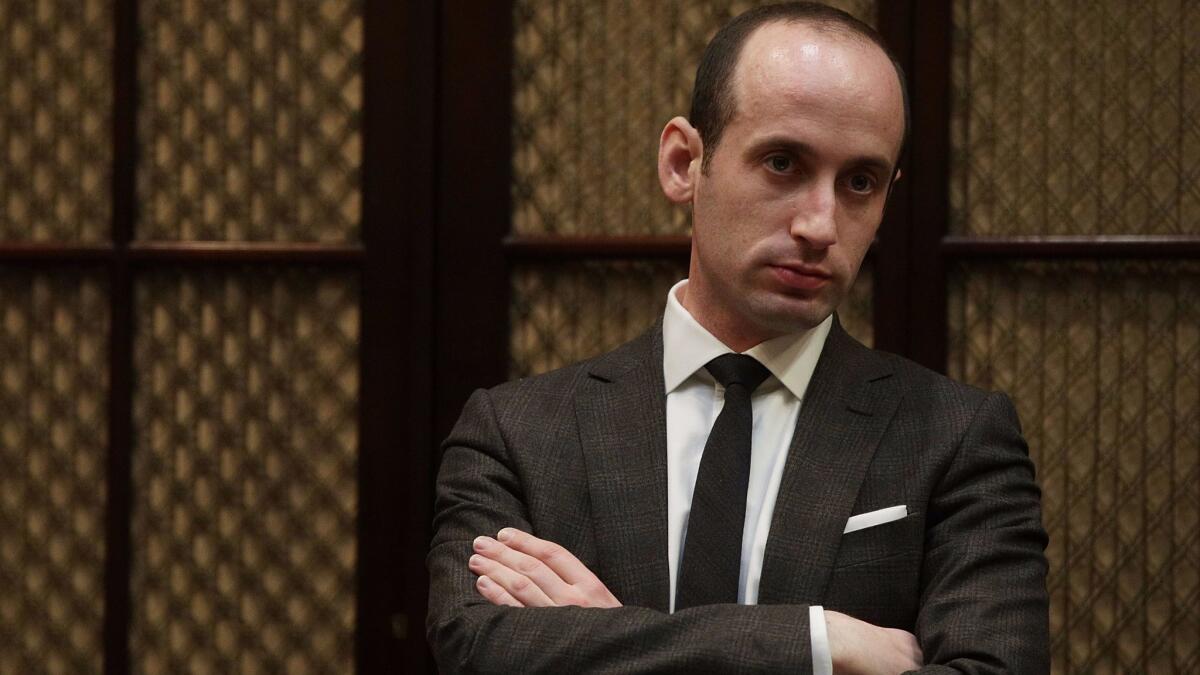Opinion: Stephen Miller was no hero fighting left-wing oppression at Santa Monica High School

Stephen Miller would eagerly tell you he’s from a liberal paradise, and I’d have to agree with him. Growing up in Los Angeles, I have always noticed my views on gun control and women’s rights rarely provoked a challenge. Locally, I have been represented by women and minorities in Congress and on my City Council.
Comfortable as I am with my hometown’s reputation, I came away from reading The Times’ piece last month on President Trump’s thirtysomething advisor with a bad taste in my mouth. Miller — a 2003 graduate of Santa Monica High School, where I am a senior — comes across as a heroic figure, a conservative treading water in a sea of overwhelming liberalism. Readers could be forgiven for believing the rest of Santa Monica High School’s student body to be a bunch of “too-cool-for-school” sensitive progressives whose only goals are to promote their agendas and vanquish the opposition.
I won’t pretend that I’m not living in a bubble. Nor will I pretend there are people in my community and in my school who would rather not hear the opinions of the other side. However, I have come to know Santa Monica High School as a place where activism thrives, where people are encouraged to share their beliefs and fight for them. The walls of my classrooms are not lined with partisan, lovey-dovey shrines to Barack Obama; rather, they display rousing reminders to do the right thing even if you’re the only one saying anything, including quotes from Martin Luther King Jr. that transcend partisanship.
Conservatives in Santa Monica are in the minority, but they are generally argued against, not bullied into silence.
Conservatives in Santa Monica are in the minority, but they are generally argued against, not bullied into silence. Miller would have us believe something else, and readers of The Times’ article might sympathize with him. Our school is portrayed as a “culturally sensitive environment” filled with unpatriotic students who “slouched in their chairs” while Miller valiantly recited the Pledge of Allegiance each morning. I don’t recite the pledge every morning, but I do not sneer any anyone who does.
Incredibly, Miller describes his years at Santa Monica High as having presented challenges that “were some of the toughest I faced in life.”
What about the challenges that Latino and black peers of Miller faced because of his denial of the existence of institutional racism, outlined in opinion articles he wrote for Frontpage Magazine? Or the challenges of students involved in Movimiento Estudiantil Chicano de Aztlan, or MEChA, an organization designed to help Chicano students become educated and politically active, who were characterized by Miller in another one of his articles as members of “a radical national Hispanic group that believes in racial superiority and returning the southwestern United States to Mexico to create a ‘bronze nation’”? Or the challenges faced by Muslim students who had to deal with a classmate who penned an article titled “A Time to Kill” about his support for the Iraq war and responding violently to Islamic radicalism? What about my economics teacher, a woman who taught Miller government and was falsely accused by him in a radio interview of disparaging the founding fathers and the Constitution, resulting in threats to her safety?
The communities that suffered the ill effects of Miller’s bombast receive only passing mention in The Times’ piece, but there’s plenty to suggest that Miller really showed us precious snowflakes.
Furthermore, the piece gets a few basic things wrong about Santa Monica, among them being its reference to the city as a “liberal enclave.” An enclave of where? Los Angeles, one of the most progressive cities and counties in the country? California, a state where Hillary Clinton received upward of 4 million more votes than Trump?
What about the description of Santa Monica before 2000 as being “a laid-back coastal community of rundown rent-controlled apartments” that “suffered from entrenched working-class poverty and on-again, off-again gang violence,” while also describing us as a town of wealthy elites? The era of run-down buildings and rampant crime passed long before Miller was in high school. Miller surely did not come of age on the hard, mean streets of Santa Monica — because those hard, mean streets had mostly changed by the time he was a toddler.
To some, my response fits in with the behavior of a whiny, sensitive liberal, the kind of Santa Monica progressive Miller loved to annoy. But I’m only doing what Santa Monica High teaches students to do, especially when a misleading article in The Times portrays us in an unflattering light: standing up for what I believe is right.
Raffaella Gumbel is a senior at Santa Monica High School. This piece was adapted from a previously published article in the school’s student newspaper, the Samohi.
This piece is part of Blowback, our online forum for rebuttals to The Times. If you would like to write a full-length response to a recent Times article, editorial or Op-Ed and would like to participate in Blowback, here are our FAQs and submission policy.
Follow the Opinion section on Twitter @latimesopinion and Facebook
MORE FROM OPINION
Shoring up Trump’s shaky ship of state
Trump’s foreign policy is incoherent. But it could be worse
What explains CPAC’s dance with Milo Yiannopoulos? The enemy of my enemy is my ally
More to Read
A cure for the common opinion
Get thought-provoking perspectives with our weekly newsletter.
You may occasionally receive promotional content from the Los Angeles Times.






